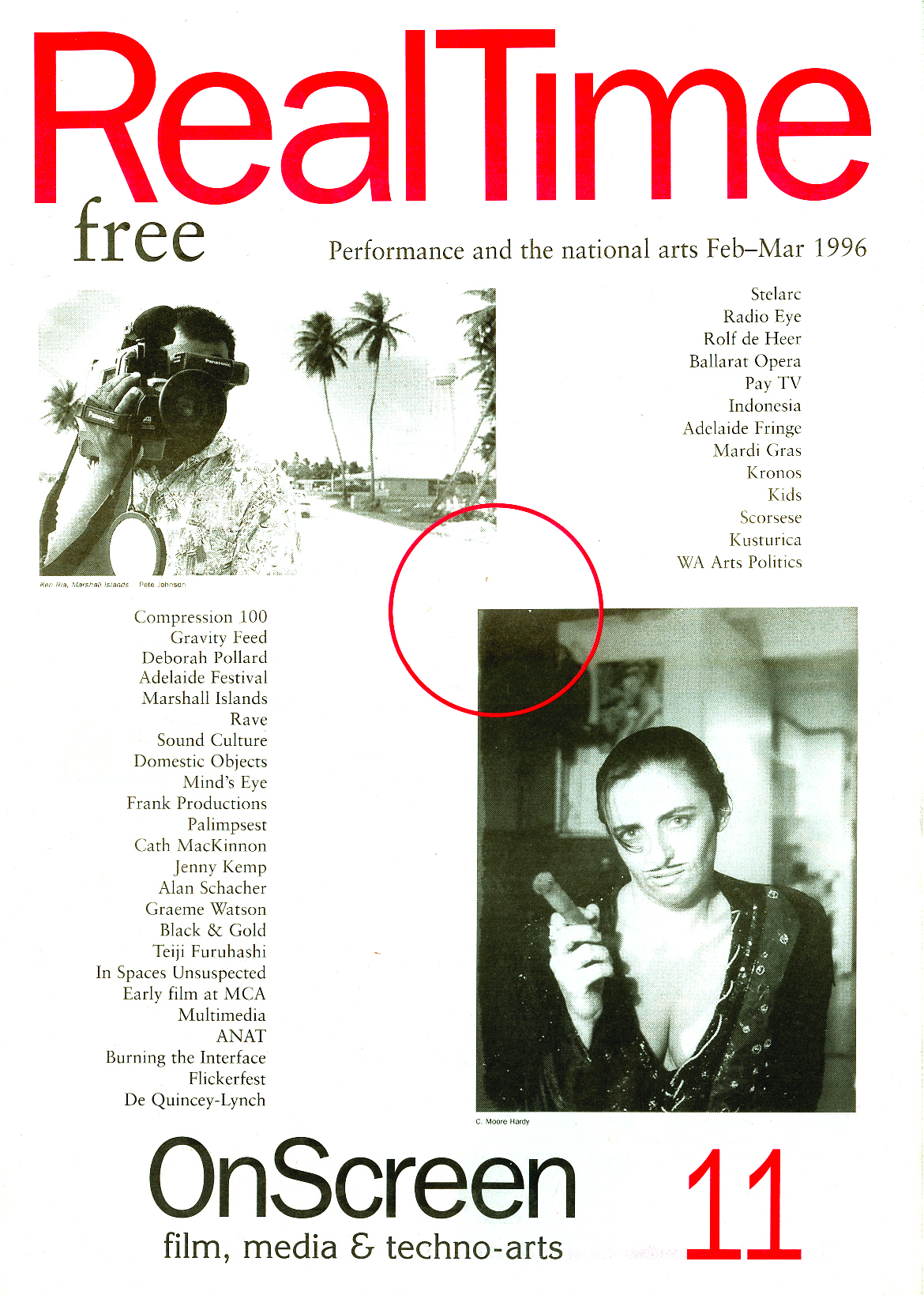
The art of struggle
RealTime Issue 11, February – March 1996
Something that strikes me is that your work is very human, not abstract. In Inhabitation, at Sidetrack Theatre last year, the particular weight of those doors seemed very funny, because you had to wonder what these people were doing this for, carrying around these monumentally unwieldy objects. Similarly in D-VOID, recently shown on SBS TV, I liked the caricatures. I also wondered how aware you were of why people might find it funny.
AS I’ve been told that the concerns with which we’re working in the shows are not visible to the audience. Friends have commented that a Gravity Feed performance can be like watching the Twelve Tasks of Hercules, but that’s not the intention. In fact my interest is the opposite, to actually be anti-spectacular. Inhabitation demonstrated the effects of complying with or resisting gravity, of building and dismantling. It was about inhabiting the spaces that we built, the set and the theatre space, whilst in a constant struggle with that set.
There certainly was a struggle.
AS The weight was incidental, but it was real. The humour is partly in juxtaposing types, selecting people of different sizes, body build, ages. We’re not trying to pre-determine where it’s going to be funny but we already know it will be because of the structure, those five people, and how serious we are about doing it. My interest in random events supports a respect for humorous content.
What the caricatures create is about people living in the world, a very human thing. When you or Ari Ehrlich are on stage, I don’t get the sense that it’s an act, despite the artistry behind it.
AB I think that’s a good thing. The body itself is our material, stripped, but marked by history, culture and upbringing. We inhabit multiple bodies: traditional, emotional, physical bodies, imaginary bodies, bodies of knowledge. In terms of Butoh, we strive to speak to an original or pre-cultural body, loading it down with imagery. The images Ari and I negotiate are not for the body, but are about the situation, and the tasks being performed within that. We don’t think about it as imaginary. We’re trying to generate an atmosphere—the performance event—and that atmosphere is real.
The images are very dense, people seemingly victimised by situations.
AS Density is certainly something that interests me. The strongest image perhaps is as if the body were inside a slab of rock, vibrating ever so minimally, suspended inside, matter giving way to matter, bodies pitted against other bodies, raw material. If we use doors, the body is pitted against the doors. If we use fire or ice, it’s more than metaphor. It’s direct substance of which we and our small world are made.
When you talk about the work, it sometimes seems quite different from what it can be about for an audience.
AS From my point of view, the work is developed from an intuitive response to the possibilities of a space. Then comes a long process, sorting ideas, references, options, possibilities, readings and misreadings. When it comes back down to working, it does tend to be physical and intuitive again. I trust that source material has become deeper content.
Do the sequences of events arise from the physicality of it or from somewhere else?
AS The work is about the atmosphere it’s attempting to establish. It isn’t made purely listening to the body dialogue. The sound environments created for us by Rik Rue are basically synonymous with what we’re doing now, and make it real. His apprehension of the world complements mine. As soon as I have a structure that can be communicated, I take him to the space. We won’t discuss the sound. Sometimes he’ll ask me questions, but usually he stops me before I’ve told him as much as I want to. And he’ll go away and come back with a composition which seems invisible when you first listen to it on cassette because it already fits the space.
When you talk about the space, it’s something that’s a physical, dense thing, full of matter already.
AB Traditionally, Gravity Feed colonises, inhabits, impregnates, infiltrates, reinterprets the venue. We’ll bring the 24 doors to The Performance Space as a metaphor for the fabric of our built environment. In Inhabitation many of the tasks dealt with moving the doors or building with them. The new show is a continuation of this, and we’re editing quite severely because we felt we failed in our contract with the audience the last time.
The new show will be based on our response to the presence of an audience. Perhaps the contract I talked about is not with the audience, but with ourselves—that we will more fully address their presence as inseparable from the event. My sense of obligation to the audience is that I owe them an intelligence which may be enacted in any number of ways. I also operate within a history of performance art, where the primary concept is being demonstrated either on the body, spatially or temporally. For example, the artist is hidden under the floor, or the event has already happened.
At The Performance Space we know many of our audience, the history of the kind of shows that have been there, almost every nook and cranny, how it’s been used. There are certain foregone conclusions which we want to undermine. Our focus is in looking at old things afresh, overlooked things, until they spring out again.
–
The members of Gravity Feed are Alan Schacher, Ari Ehrlich, Dennis Beaubois, Tim Rushton, Jeff Stein. In the House previews at The Performance Space, Sydney March 16 and 17, then runs 20-31 March.






